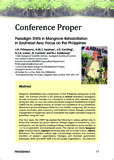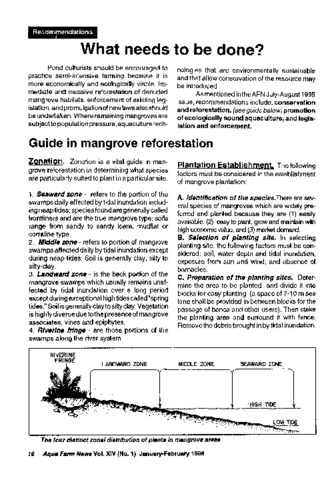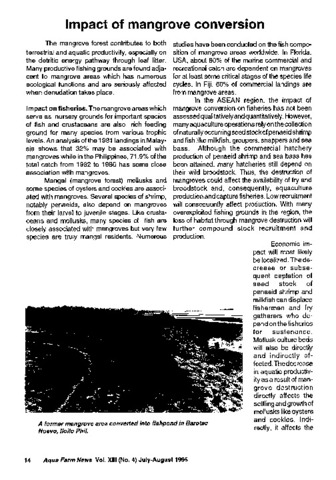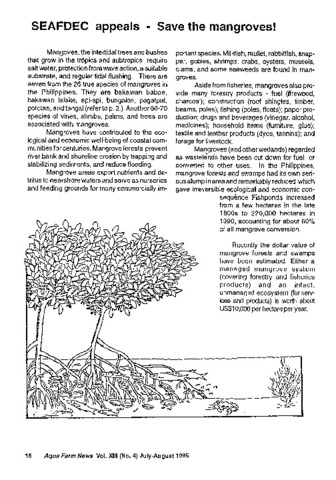Paradigm shifts in mangrove rehabilitation in Southeast Asia: Focus on the Philippines
Share
Abstract
Mangrove rehabilitation has a long history in the Philippines dating back to the 1930s. The standard practice is the planting of bakhaw Rhizophora propagules by paid community members (or volunteers) in seafront sites selected during spring low tides. In 2009, the Community-based Mangrove Rehabilitation Project (CMRP) of the Zoological Society of London was established to: (a) rehabilitate abandoned government-leased fi shponds into healthy mangroves; (b) increase coastal protection, food resources, and livelihood income through sustainable management of mangroves; and (c) re-establish the legally mandated mangrove ‘greenbelt’ along the coast.
Over four years, the CMRP has planted the following in various partner sites in Panay and Guimaras: (a) 58,000 seeds or wildings bagged in nurseries by 3,000 participants, and (b) 99,000 seedlings/wildings outplanted by 4,000 planters in ~20 ha of greenbelts and abandoned ponds. The species are mainly bungalon/piapi Avicennia marina, pagatpat Sonneratia alba, and to a lesser extent, bakhaw Rhizophora. The planters include high school/college students and teachers, members of people’s organizations, barangay and municipal government employees, BFAR and DENR staff , and civil society organizations. The extensive CMRP trials have yielded signifi cant learnings, many of them paradigm shifts from present protocols, as included in the 20 Golden Rules of Mangrove Rehabilitation. A manual that documents these learnings with concrete examples based on CMRP monitoring of fi xed quadrats and other standardized protocols, is currently in press. Some of these protocols are the following: (a) planting site: shift from seafront sites to abandoned ponds (whenever possible); (b) time of site selection: during (low tide of) Neap Tide rather than Spring Tide; (c) species selection for seafront sites: the ecologically correct bungalon/piapi and pagatpat, rather than the easy-to-plant but unsuitable bakhaw; (d) sources of planting materials: use of available wildings is harvesting nature’s excess (equivalent to withdrawing from ‘seedling banks’), which also saves time; (e) labor: “No Pay” planting is based on the premise that labor contributed by the community provides the basis for ownership, thereby obligating them to nurture the plants to maturity and validating their role as de facto managers of mangrove resources.
Similar mangrove initiatives have been observed elsewhere in Southeast Asia, as follows: (a) barriers/breakwater in MaIaysia, Vietnam, and Thailand; (b) use of wildings in Malaysia; and (c) mangrove ecoparks/reserves in Singapore, Thailand, Vietnam and Brunei.
Suggested Citation
Primavera, J. H., Guzman, A. M. T., Coching, J. D., Loma, R. J. A., Curnick, D., & Koldewey, H. J. (2014). Paradigm shifts in mangrove rehabilitation in Southeast Asia: Focus on the Philippines. In H. G. Palis, S. A. Pasicolan, & C. I. Villamor (Eds.), Proceedings of the 1st ASEAN Congress on Mangrove Research and Development, 3-7 December 2012, Manila, Philippines (pp. 17-30). Manila, Philippines: Department of Environment and Natural Resources - Ecosystems Research and Development Bureau (DENR-ERDB).
Subject
mangroves  ; mangrove conservation
; mangrove conservation  ; mangrove restoration
; mangrove restoration  ; nature conservation
; nature conservation  ; coastal zone management
; coastal zone management  ; mangrove swamps
; mangrove swamps  ; policies
; policies  ; Climatic changes; environmental protection
; Climatic changes; environmental protection  ; aquaculture
; aquaculture  ; legislation
; legislation  ; site selection
; site selection  ; Rhizophora; Avicennia; Sonneratiaceae; Sonneratia; Philippines; South East Asia
; Rhizophora; Avicennia; Sonneratiaceae; Sonneratia; Philippines; South East Asia
 ; mangrove conservation
; mangrove conservation  ; mangrove restoration
; mangrove restoration  ; nature conservation
; nature conservation  ; coastal zone management
; coastal zone management  ; mangrove swamps
; mangrove swamps  ; policies
; policies  ; Climatic changes; environmental protection
; Climatic changes; environmental protection  ; aquaculture
; aquaculture  ; legislation
; legislation  ; site selection
; site selection  ; Rhizophora; Avicennia; Sonneratiaceae; Sonneratia; Philippines; South East Asia
; Rhizophora; Avicennia; Sonneratiaceae; Sonneratia; Philippines; South East Asia
Collections
Related items
Showing items related by title, author, creator and subject.
-
What needs to be done?: Guide in mangrove reforestation
Southeast Asian Fisheries Development Center, Aquaculture Department (Aquaculture Department, Southeast Asian Fisheries Development Center, 1996)The article presents a two-part guideline in mangrove reforestation. The first part is zonation, which is the process of determining what species are particularly suited to plant in a particular site. While, plantation ... -
Impacts of mangrove conversion
Southeast Asian Fisheries Development Center, Aquaculture Department (Aquaculture Department, Southeast Asian Fisheries Development Center, 1995)The article presents the impact of mangrove conversion on fisheries and on coastal areas. The mangrove areas which serve as nursery grounds for important species of fish and crustaceans are also rich feeding ground for ... -
SEAFDEC appeals - Save the mangroves!
Southeast Asian Fisheries Development Center, Aquaculture Department (Aquaculture Department, Southeast Asian Fisheries Development Center, 1995)The article presents action plans that could be done to stop and prevent further degradation of the mangrove ecosystem. These action plans are: conservation, mangrove reforestation and the practice of ecologically sound ...




